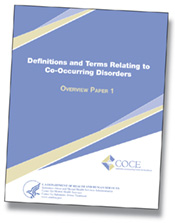Series on Co-Occurring Disorders Available
Co-occurring substance abuse and mental disorders affect
approximately 4.6 million people in the United States.
However, only a small percentage of these people receive
treatment that addresses both disorders, and many do
not receive treatment of any kind.
To better educate states, communities, and behavioral
health care providers, SAMHSA’s Co-Occurring Center
for Excellence (COCE) recently released the first 3 in
a series of 10 overview papers for treatment professionals
on co-occurring substance abuse and mental disorders.
| |
"These overview
papers on co-occurring disorders break new ground.
They help create a common language and a common
understanding of co-occurring disorders for both
mental health and substance abuse providers."
—Lawrence
Rickards, Ph.D.
Chief, Homeless Programs Branch
SAMHSA's Center for Mental Health Services |
|
Concise and easy to read, these three
COCE overview papers are introductions to the latest
information on this issue. Following is a synopsis of
each COCE overview paper:
 1.
Definitions and Terms Relating to Co-Occurring Disorders.
To avoid confusion in terminology and to provide a starting
point for dialogue among service providers, administrators,
financing agencies, and policymakers, this overview paper
compiles definitions consistent with state-of-the-art
science and treatment practices relating to co-occurring
disorders (COD). 1.
Definitions and Terms Relating to Co-Occurring Disorders.
To avoid confusion in terminology and to provide a starting
point for dialogue among service providers, administrators,
financing agencies, and policymakers, this overview paper
compiles definitions consistent with state-of-the-art
science and treatment practices relating to co-occurring
disorders (COD).
2.
Screening, Assessment, and Treatment Planning for Persons
with Co-Occurring Disorders. Clients with
COD are best served through an integrated screening,
assessment, and treatment planning process that addresses
both substance use and mental disorders, each in the
context of the other. This overview paper discusses the
purpose, appropriate staffing, protocols, methods, advantages
and disadvantages, and processes for integrated screening,
assessment, and treatment planning for persons with COD
as well as systems issues and financing.
3.
Overarching Principles To Address the Needs of Persons
with Co-Occurring Disorders. This overview
paper outlines 12 basic principles for working with persons
with COD. These principles are intended to guide—but
not define—systemic and clinical responses. There
are two sets of principles—one for systems of care
and another for individual providers. They can be used
as benchmarks to assess whether plans or programs are
consistent with the best information in the field.
The overview papers span topics such as epidemiology,
treatment, workforce and systems issues, prevention and
early intervention, and evaluation and monitoring. Intended
audiences include mental health and substance abuse treatment
providers and policymakers at state and local levels,
as well as their counterparts in American Indian tribes.
SAMHSA developed these materials following the November
2002 release of the Report to Congress on the Prevention
and Treatment of Co-Occurring Substance Abuse Disorders
and Mental Disorders.
Co-occurring disorders are more common than most professional
counselors, medical personnel, or the general public
realize. The significant effects of untreated COD—homelessness,
unemployment, incarceration, physical health problems,
separation from family and friends, and often suicide—led
SAMHSA not only to establish COCE, but also to create
a broad range of grant programs, policy academies, and
training opportunities. SAMHSA also developed a Treatment
Improvement Protocol (TIP)—Substance
Abuse Treatment for Persons with Co-Occurring Disorders
(TIP 42).
As a result, the diagnosis and treatment of COD are
now better defined, and treatment is becoming more integrated.
These
free overview papers can be ordered by calling SAMHSA’s
National Clearinghouse for Alcohol and Drug Information
at 1 (800) 729-6686 (English and Spanish) or 1 (866)
889-2647 (TTY).
 For
more information about the Co-Occurring Center for Excellence,
visit www.coce.samhsa.gov. For
more information about the Co-Occurring Center for Excellence,
visit www.coce.samhsa.gov. 
«
Previous Article
See
Also—Next Article »
Back to Top |




